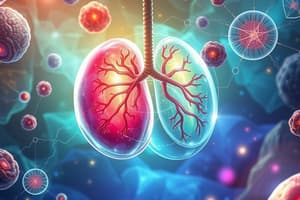Podcast
Questions and Answers
What is the primary product of glycolysis, and how is it further processed in cellular respiration?
What is the primary product of glycolysis, and how is it further processed in cellular respiration?
The primary product of glycolysis is pyruvate, which is further processed in pyruvate processing before entering the citric acid cycle.
Explain the role of oxygen in aerobic respiration compared to anaerobic respiration.
Explain the role of oxygen in aerobic respiration compared to anaerobic respiration.
Oxygen is essential in aerobic respiration for the electron transport chain and oxidative phosphorylation, while anaerobic respiration does not require oxygen to produce ATP.
What occurs during the citric acid cycle, and how does it contribute to ATP synthesis?
What occurs during the citric acid cycle, and how does it contribute to ATP synthesis?
During the citric acid cycle, acetyl-CoA is oxidized, generating high-energy electron carriers (NADH and FADH2) that feed into the electron transport chain for ATP synthesis.
Describe the process of oxidative phosphorylation and its significance in cellular respiration.
Describe the process of oxidative phosphorylation and its significance in cellular respiration.
What are the main differences between anaerobic respiration and fermentation in terms of end products and efficiency?
What are the main differences between anaerobic respiration and fermentation in terms of end products and efficiency?
Flashcards
Glycolysis
Glycolysis
Oxidizes glucose to pyruvate, harvesting chemical energy.
Pyruvate processing & Citric Acid Cycle
Pyruvate processing & Citric Acid Cycle
Complete energy-yielding oxidation of organic molecules.
Electron Transport & Oxidative Phosphorylation
Electron Transport & Oxidative Phosphorylation
Completes ATP synthesis.
Aerobic Respiration
Aerobic Respiration
Signup and view all the flashcards
Anaerobic Respiration/Fermentation
Anaerobic Respiration/Fermentation
Signup and view all the flashcards
Study Notes
Glycolysis
- Glycolysis oxidises glucose to pyruvate, releasing chemical energy.
- This is the first step in cellular respiration.
Pyruvate Processing and Citric Acid Cycle
- These steps complete the oxidation of organic molecules.
- They are part of cellular respiration.
Electron Transport, Oxidative Phosphorylation, and Chemiosmosis
- These steps complete ATP synthesis.
- Also part of cellular respiration.
Oxygen Requirement
- Glycolysis does not require oxygen.
- Steps after glycolysis (pyruvate processing, citric acid cycle, electron transport, oxidative phosphorylation) require oxygen.
- This makes the latter steps of cellular respiration aerobic.
Alternative Energy Production
- Anaerobic respiration and fermentation allow ATP production without oxygen.
Studying That Suits You
Use AI to generate personalized quizzes and flashcards to suit your learning preferences.




